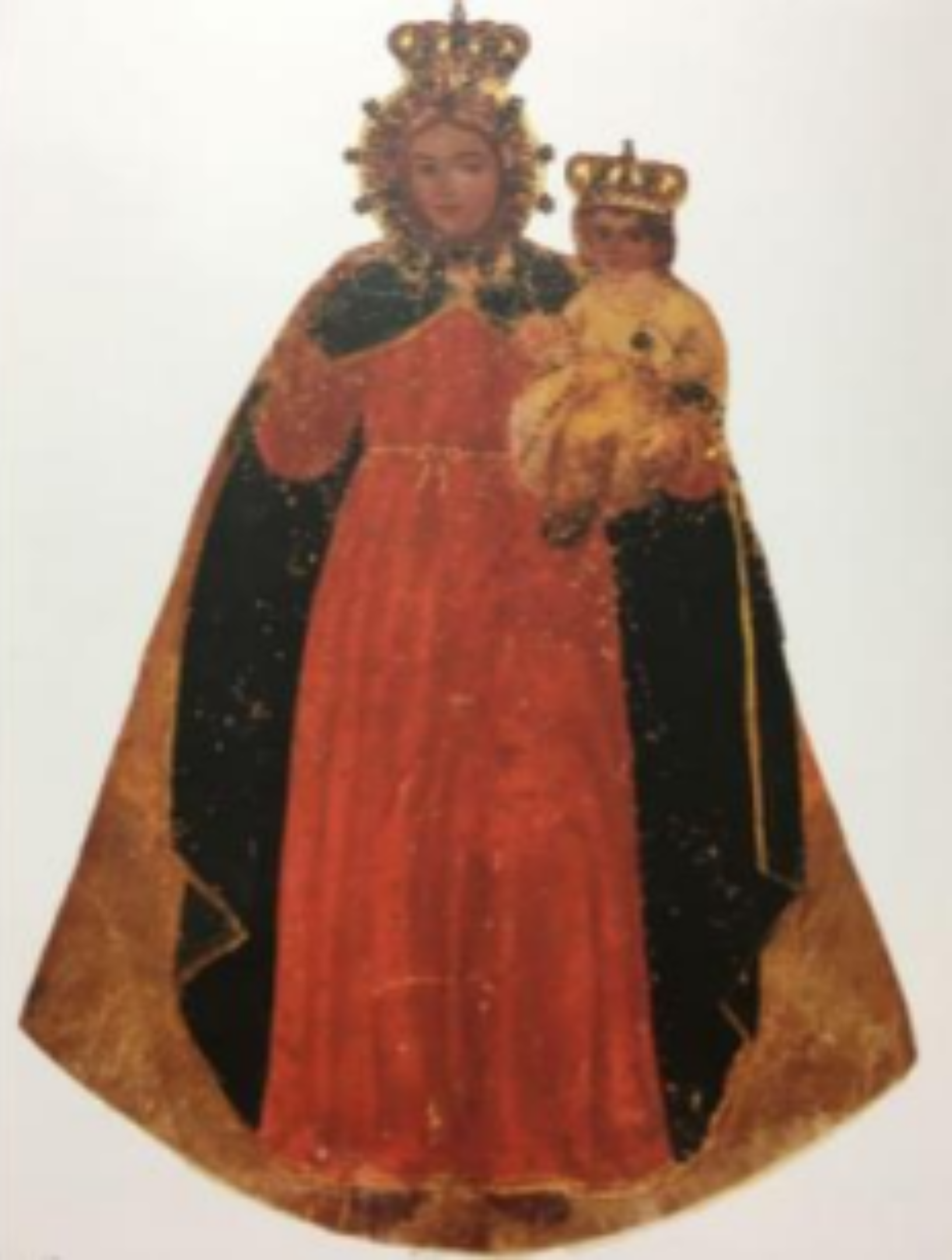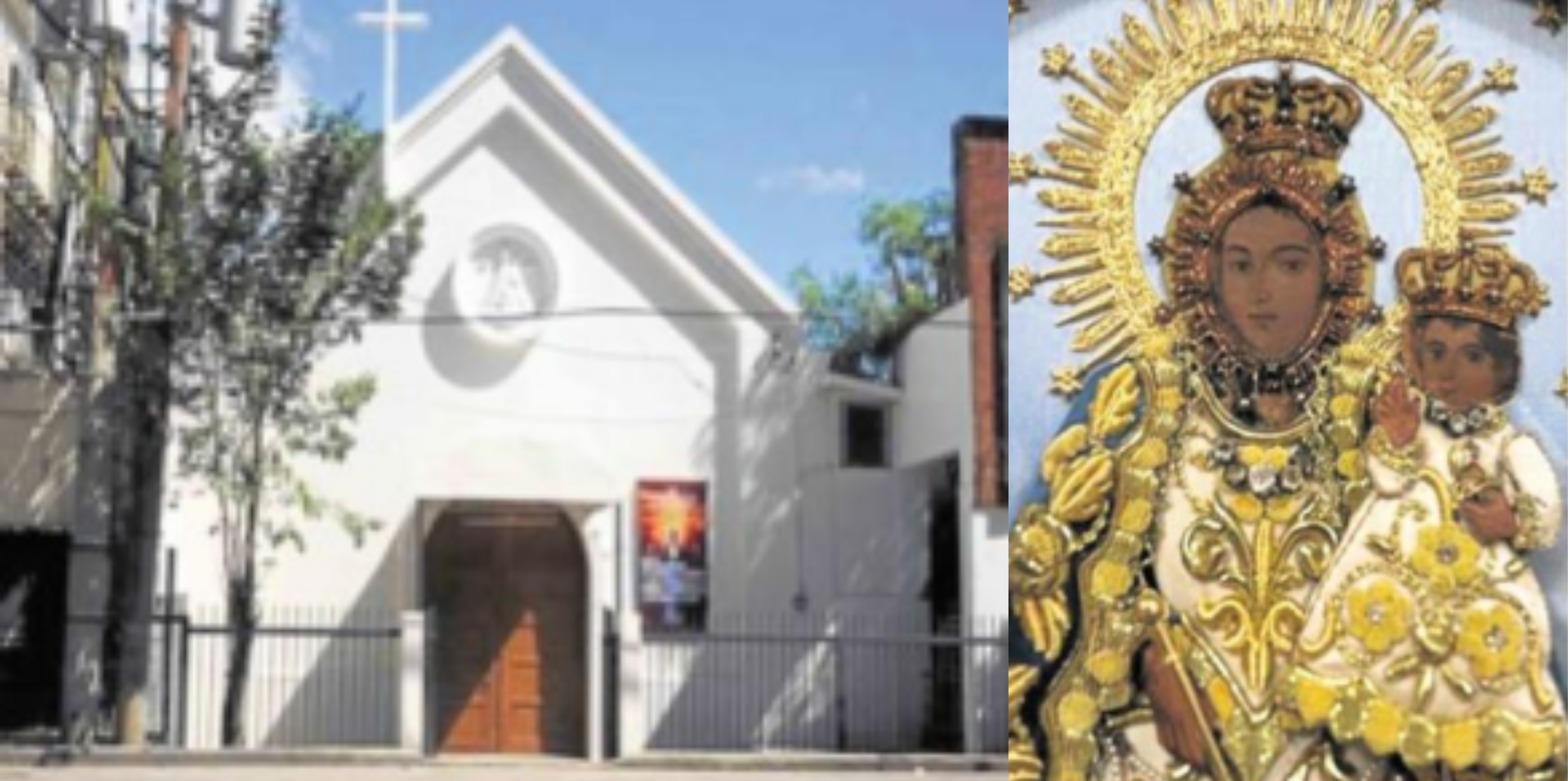Miracle of Our Lady of the Rosary, 1854
“Of course, it was a miracle,” everyone who had seen or heard about the great fire in Barrio San Miguel on April 16, 1854 agreed.
Not prepared to readily accept that the event had been “a miracle,” Francisco G. Ortiz, the Archbishop of Manila, decided to initiate an investigation to determine fact from exaggeration and false premises.
Reverend Father Domingo Azorin, Barrio San Miguel’s parish priest, assigned to the task, looked into the event with great care and perseverance, to accurately document his findings.

The image of Our Lady of the Rosary, unharmed during the great fire, is an oil painting 40 cm wide and 50 cm high (15.7 x 19.6 inches). A thick blue cloth mantle richly embroidered in gold thread cloaked her original painted-on crimson gown. The account of “La Virgen Maria Venerada: en sus Imagines Filipinas,” translated from Spanish in 1904, and found in the University of Santo Tomas Archives, described her gown as being of white silk. From time to time, devotees would cloak the Lady, and the Santo Niño in various expensive garments. Contributed photo
At issue was whether or not in the terrible fire that consumed dozens of houses in Barrio San Miguel (today’s Carlos Palanca Street), a miracle had saved the only structure remaining untouched by the fire: the nipa and bamboo visita in which stood the image of Our Lady of the Rosary carrying the Christ Child. Had it been saved by firemen or the villagers? It had remained totally unscathed, including even the grass surrounding the visita.
READ: Our Lady of the Rosary’s ‘miracle of the fire’
In fact, firemen had rushed down the Ayala Bridge to turn left into the raging inferno, but it was too intense. They had to go through San Sebastian Street, but when they arrived at the area, the fire had died down.
Article continues after this advertisementDon Bonifacio Jose De Vera, a principales of the barrio, testified: “As one of the neighbors of the community in which the hermitage situates, I saw and witnessed the horrible fire, my house being one of those that were burned, and became more astounded when, as the fire started to come near the ermita, the fire suddenly was extinguished, leaving the ermita without any damage; and what is more surprising, is that grass that surrounded the ermita did not lose its freshness, evoking everyone’s admiration; and no one could say that the ermita could be delivered from the fire’s fury without neither firemen, nor by any human help.”
Article continues after this advertisement“My house, which was burned, was eight yards from the side of the ermita or visita of Our Lady of the Rosary, and (I) saw that the flames from my house and the other houses beside the ermita were about to fall on the roof of the chapel, and some sparks of fire also died by the strong wind and indeed it is admirable to see that the ermita was saved from the fire, even if there had not been any help, for when the firemen approached the place, the fire was already extinguished,” Doña Isabel Frias, a Spanish mestiza, said.
She continued: “That from the day after the fire, perhaps because the news of this even had already spread, there was this sudden rush of people who gave alms and others, candles, plucking some grass in the vicinity of the visita for the medicine.”
Don Pedro de Alcantara added: “I indeed saw with admiration that the ermita had not been burned, when the fire was almost upon its roof, having all the houses that were on both sides of the ermita razed to the ground. A strong wind that came from the east whipped around that chapel, and most puzzling here, is that the fire extinguished itself without the help of any person or any firemen that, at that moment, had not yet arrived at that place.”
“When the firemen arrived, the fire was almost over; so much so that the day after the fire there was a gathering of people around the said ermita, which caused so much joy, and this lasted for more than a week, and all were amazed at the hermitage or chapel, and the admiration of those who were there was so great that some offered candles to the Mother of God, and others, alms and some pulled the grass that surrounds the hermitage and said that it could be used for medicine.”
The second lieutenant of San Miguel, Don Sinforoso Victorino, said that the morning after the fire, he “approached the site and saw with awe that the ermita had been spared, and also saw a great number of people gathered to witness the fire’s aftermath.”
“I rushed to the site of the conflagration in order to assist the people as much as possible, and in fact, I was surprised to see the ermita, and that there was no other help from other people, and that only a few that dealt with much work at that moment; that when the firemen arrived, the fire was almost out; that the houses nearest to the ermita to the east and to the north were all consumed by the fire; that when the fire was out, many people came from all over and were astonished by what had happened, and everyone said that it was a miracle,” the former gobernadorcillo Don Fruto Sanches added, not having witnessed the fire himself.
“It was a true miracle that the aforementioned ermita was saved from the fury of the flames. On the occasion of the conflagration of the house adjacent to the hamlet by the east, the direction from where the fresh wind came, the houses at the back of the ermita were also burned; that due to the intensity of the fire, it crossed the adjacent stone house of Mr. Tomas Fuentes, and it was impossible for him to go to the Quintana Bridge with the firemen that the declarant had in his charge, by which they had to go with the firemen to San Sebastian Causeway toward Malacañan, and from there to the town of San Miguel, and when they arrived, they saw that the ermita was intact and the fire had died down,” Don Juan de Martin y Arevalo, assistant to the European English Engineers, narrated.
Don Antonio de Ayala, a Spanish peninsular and businessman, testified that he was “astounded to learn that this chapel of nipa was spared by the fire, because the wind went on her with great force with no aid of water pumps that would help to save it, in spite of the fact that the passages on either side of San Miguel and Quiapo were impossible to penetrate, and that the truth is, rarely has the area been as distressed as much as in the moments of the fire that day.” His impassioned testimony, a testament to faith, like the rest of the witnesses’ accounts, concluded that: “I believed that only God, who can do everything, would save the camarin.”
On the parish priest Azorin’s turning over the results of his investigation bearing witness to the event, Archbishop Ortiz, satisfied that indeed, a miracle had saved the Lady and the hermitage, ordered the original document kept in the Archbishop’s Archives in the San Miguel parish.
Astonished and impressed by the verification of the miracle, Governor-General Manuel Pavia y Lacy immediately ordered the construction of a stone chapel to replace the nipa visita. Also as a result of the miracle, the ermita’s street was renamed “Calle del Rosario,” according to an 1898 map of Manila.
READ: Our Lady of Fatima, symbol of Edsa revolution, canonically crowned
In more recent times, after World War II, fearing that the stone chapel could disintegrate, its owner, Doña Florencia G. Barretto, caused the reconstruction of the chapel in concrete. Her granddaughter, Carmencita Legarda Cu Unjieng, is the capillita’s custodian.
A story handed down through the ages tells of a Spanish high government official who sat in a tub of warm water to relieve stomach troubles, as his physician had advised. Suddenly, out of nowhere, a lovely lady with an infant in her arms appeared to him. What he needed, she said, was grass growing around a particular nipa hut which, when boiled and drank, would help him recover. With that, the lady disappeared.
The official ran to ask whether the guard had seen a lady come through the gate, but the guard said he had not. The official then sent for the grass, following the mysterious lady’s instructions, and recovered. He himself then went to the visita, where he found the same lovely lady and child at the altar. It was Our Lady of the Rosary.

The “capillita” today on Carlos Palanca Street (L) and the present image of Our Lady of the Rosary. The oil painting is 173 years old. Contributed photos
Our Lady of the Rosary’s nine-day feast is celebrated from April 20 to 28. The schedule of novenas and masses is:
- April 20, Saturday, 6:00 p.m.
- April 21, Sunday, 8:30 a.m.
- April 22, Monday, 6:00 p.m.
- April 23, Tuesday, 6:00 p.m.
- April 24, Wednesday, 6:00 p.m.
- April 25, Thursday, 6:00 p.m.
- April 26, Friday, 6:00 p.m.
- April 27, Saturday, 6:00 p.m.
- April 28, Sunday, 8:00 a.m.
To get to the capillita, traveling north on Ayala Bridge, turn left at its foot which is Carlos Palanca Street (formerly Calle del Rosario, then Echague). The white concrete chapel is 250 meters away on the right-hand side.